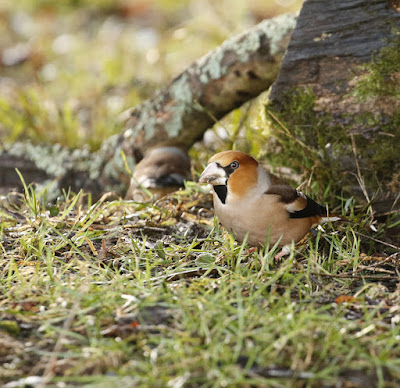Well they say you should never go back as it will not be as good as the first time but in this notable year for Hawfinches and after such a resounding success last week, the lure of more communing with this lovely, bumper sized finch proved irresistible.
Early morning darkness was still enveloping Parkend as I drew up for another session with Coccothraustes coccothraustes. As the sky slowly lightened I noticed that in the intervening days between my last visit and this current one, photographers had been busy, as evidenced by a plethora of branches and perches artificially placed under the Yews to get that extra special shot.
If that is your thing then all well and good but I am happy just to see any Hawfinches and, if chance permits, take their picture when they come to feed on the ground. The first hour brought nothing but other birders in their cars, arriving to occupy the most favourable four spaces in the lane. The second hour was almost as bad, as just Blackbirds, Dunnocks, Chaffinches, Robins and Great Tits were on show. Where were the Hawfinches?
There seemed to be many less Hawfinches today than last week so maybe this contributed to the lack of action. In all I counted no more than six during my visit but others, of this most enigmatic of finches, could just as easily have been secreting themselves in the surrounding Yews without my noticing.
 |
| Male Chaffinch |
It was not looking at all good but then a number of Chaffinches descended from the Yews, which is always a good sign and shortly after, a male and female Hawfinch joined them. They drop suddenly with a noticeable brrrrrrr of wings and, for a few seconds, stand still and erect with extended necks and heads held absolutely still as they check that all is well. They are the epitomy of nervous tension at this moment, motionless amongst the relaxed and quietly feeding Chaffinches but the latter's calmness re-assures them and soon they too start feeding by picking up the scattered sunflower seeds.
I noticed that the male was ringed with a blue colour ring on its right leg, presumably ringed by Jerry who rings and studies them at various private sites in the Forest.*
*Jerry has told me it was ringed near Parkend on 11 April 2017
I noticed that the male was ringed with a blue colour ring on its right leg, presumably ringed by Jerry who rings and studies them at various private sites in the Forest.*
*Jerry has told me it was ringed near Parkend on 11 April 2017
 |
| The colour ring on the male Hawfinch's right leg with metal BTO ring on its left leg. |
 |
| Male Hawfinch |
The long periods of subsequent waiting and hoping for a Hawfinch to appear were enlivened by a Nuthatch and its antics. Unwittingly it adopted beguilingly cute attitudes as it posed on branches and tree trunks surveying the ground, intent on collecting sunflower seeds to stash away in the nooks and crannies of the tall Beech trees across The Green. For a time a diminutive Coal Tit joined in, collecting its own seeds to similarly horde away.
 |
| Nuthatch |
An undisturbed spell finally arrived and two female Hawfinches eventually descended to feed for all of thirty seconds before they too were disturbed by someone who just could not remain in their car. He was 'advised' to get back in his car by some other birders in the car in front of me but it was too late.The Hawfinches had gone.
 |
| Female Hawfinch |
 |
| Mandarin Ducks |
 |
| Male Tufted Duck |
I turned the car for home but not before availing myself of a coffee at the friendly Postage Stamp Cafe just across from the Cricket Green in Parkend. Maybe I will return to seek out the Hawfinches once again but not for a couple of weeks. Maybe I will not. We will see.
The problem is that Hawfinches this winter are receiving a lot more publicity than usual. The unprecedented invasion this winter of Hawfinches from mainland Europe is still being widely publicised and anyone with an interest in birds wants to see one no matter their level of competence. Even BBC's Winterwatch with the estimable Chris Packham and cohorts is giving Hawfinches maximum coverage. Also, Parkend is now so well known as an easily accessible and virtually guaranteed place to see Hawfinches that it is becoming self defeating and as more and more people learn of it and come, the less the shy Hawfinches are evident.
It is no one's fault in this overcrowded island and everyone has a perfect right to come and see them and it would be wrong to begrudge anyone the thrill of seeing Hawfinches.
I think, though, I may need to find somewhere else.




















































